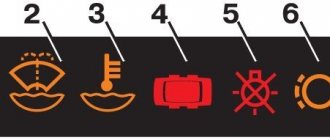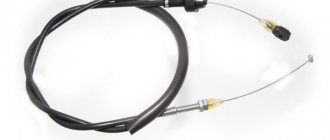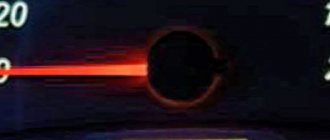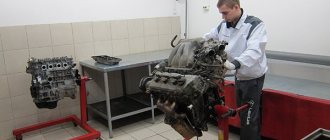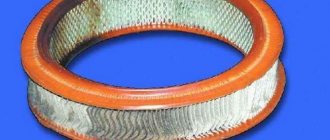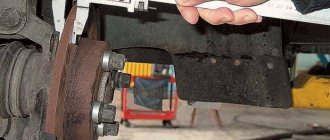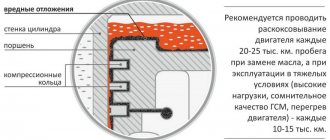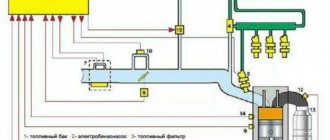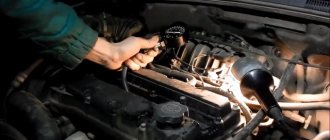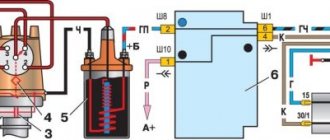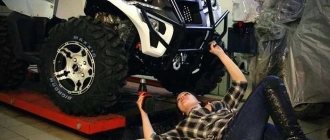Why do dips appear when you press the gas pedal? How to fix this problem?
The meaning of the word failure, whatever its meaning, is always negative and negative, no matter how it is pronounced and no matter where it is used.
When they talk about the gas pedal and its failure, it can be noted that this event is really very unpleasant and dangerous due to the fact that when the driver presses the pedal, instead of the expected acceleration of the car, he sees its complete inaction or a small jerk. But the most dangerous thing is if this phenomenon occurs while overtaking another car, which usually does not end well.
In simple terms, gas failure is when when you press the pedal there is no reaction from the car's engine. When you press the gas and the car doesn't accelerate. More precisely, the acceleration is still small, but occurs with a large delay.
A late reaction can be combined with a sudden jerk of the car, which also does not do anything good, because an emergency situation can be created.
It must be emphasized that the occurrence of such damage very often occurs due to problems with the vehicle’s fuel system. But there are also other reasons that cause gas leaks while the car is moving.
Speaking about the reasons, it is worth noting that they most often lie in high-voltage wires and spark plugs of the car.
Namely, car spark plugs are often to blame. Due to poor fuel, a coating appears on the spark plugs, which is the cause of poor performance and lack of engine response to gas.
But the problem may also be related to armored wires, which must be constantly checked and, if necessary, replaced.
The same applies to candles, which also need to be monitored.
A common cause of poor vehicle response is the injectors. In old cars that have high mileage, due to poor fuel, the injectors become clogged, which is why atomization does not occur. That's why it flows like a stream.
Due to erroneous operation of the injectors, the air-fuel connection becomes leaner, which leads to dips when pressing the gas.
The breakdown can be removed by cleaning the injectors yourself or in a car service using special equipment.
Also, the reason may be in the throttle, which, due to contamination, begins to jam and function poorly.
It can also be removed by simply cleaning the part, as when dismantling it, in the throttle module, using a special liquid.
Source
Answers@Mail.Ru: Why does the car sneeze?
Citroen in Russia has one problem: it does not recognize bad gasoline. Fill up with good gasoline at trusted gas stations and you will forget what car repair is.
because you need to change the filter and refill with good gasoline
I'm sick)) fill up with other gasoline
carburetor or injector?
This is the hair color, as soon as you change everything will be normal, I’m allergic to peroxide :)
Most likely she has a cold, check that her nose isn’t running?
Maybe the guy under the hood has a dry throat. Take care of him. Don't be cruel.
the carburetor is sick, take it to the doctor for a car service
Sergej Lehmann is right, my girlfriend had the same thing on C5, but diagnostics won’t hurt.
It is necessary for diagnostics, it is expensive, but the answer will be accurate!
Main reasons
When dips appear when you press the pedal, you need to check the following elements.
- Set of high-voltage wires and spark plugs. The latter are criticized more often than other details. If the owner regularly refuels with fuel with harmful additives, over time the electrode becomes overgrown with carbon deposits, as a result of which the spark supply deteriorates. If the source of the problem is a high-voltage wire, you will have to replace it. Better - the whole set at once.
- Injectors. Again, the injection engine does not respond well to clogged fuel injectors. A lean fuel mixture results in the engine not responding to pressing the gas pedal. There are two options - washing in an ultrasonic bath, or completely replacing the kit.
- Throttle valve. If there is a large layer of dirt, it jams, which leads to incorrect operation. The resulting deposit prevents the throttle from functioning normally.
Note! If the cause of the breakdown is a broken wire, it is better to buy the entire set - it is possible that other wires will begin to behave the same way.
When pressed hard
- incorrect ignition setting;
- air filter clogged;
- failure of the high pressure fuel pump.
These are the main reasons why a car behaves this way when you press the gas pedal hard. Typically, this behavior is observed for one or two seconds, after which the engine, having reached medium speed, continues to operate without problems.
RPM failure
A drop in speed is manifested by the lack of engine response to the pressed gas pedal. When the driver tries to pick up speed, the car does not react at all, or does it too late. This manifests itself as follows:
- A short dip lasting 3-5 seconds. But this is enough to create a dangerous situation on the road.
- Prolonged lack of response. Up to ten seconds, sometimes more. The car has every chance of stalling.
- Jerks with jerking. Duration - about two seconds.
- Numerous consecutive jerks. The engine operates differently when the gas pedal is in one position.
- A series of deep failures. The car is shaking seriously.
Injector
To determine the causes of failure when pressing the gas pedal in the injector, special diagnostic equipment is used. In most cases, improper operation occurs due to a faulty throttle position sensor. First it checks:
- fine filter clogging level;
- stability of the fuel pump;
- cleanliness of the mesh filter on the intake;
- pressure level inside the fuel rail. Range – 2.8-3.2 bar;
- condition of fuel supply and mixture formation sensors;
- number of errors in the ECU memory;
- condition of the injectors.
Assessment of the condition of the throttle valve, control unit and set of injectors is carried out only in the service class=”aligncenter” width=”700″ height=”400″[/img]
Gas distribution mechanism
Incorrect adjustment of the valve timing or various malfunctions in the operation of the timing belt lead to the fact that the opening of the intake and exhaust valves occurs untimely. Because of this, exhaust gases from the combustion chamber may not be completely removed, or the chamber will not be completely filled with air or the fuel mixture.
In both cases, you can observe the following unpleasant signs:
- Problems with startup and in almost all cases;
- Unstable motor operation;
- Significant reduction in engine power, the car does not pull;
- The engine stalls quite often;
- In the most severe cases, the engine may simply seize.
If problems with speed appear after replacing the timing belt or chain, most likely the problem is due to incorrect installation of the teeth or belt tension. Even if no repair work has been carried out recently, it is worth checking the condition of the belt, as well as the correct settings of the timing marks, in order to exclude the possibility that the belt has jumped a certain number of teeth relative to its original position.
Diagnostics
Checking the injector is faster because there is an electronic control unit. After reading the error codes, the source of the problem can be clearly identified. Carburetor cars do not have this option. Therefore, such a system is diagnosed in its own way.
First you need to check the coherence and correct operation of the fuel system. You have to probe all the places where air leaks may occur. The fuel pump and fuel line are also checked. There should be no deposits or blockages.
If the test results do not reveal any problems, the failure most likely occurs due to the carburetor. This is the main device responsible for mixture formation and intake into the manifold. When the carburetor is working properly, fuel flows evenly without interruption.
Troubleshooting
The sequence of actions is as follows.
- Eliminate air leaks caused by loose fasteners on the exhaust manifold.
- Check the condition of the fuel filter.
- Remove the idle air control valve with the sealing ring and check their condition. It works correctly when a click appears when connected to the positive terminal (the negative is connected in advance).
- Check the fluid level in the float chamber. The tolerance is the middle of the inclined wall.
- Blow out the fuel and air jets with an air compressor and clean the emulsion tubes.
- Use carburetor cleaner to remove carbon deposits from the carburetor walls.
Why does the engine seem to choke when you sharply press the gas pedal?
In this case, you should start by checking the spark plugs. Quite often the problem can be solved simply by replacing the spark plugs. If this does not help and the “check” light on the dashboard is on, you should conduct computer diagnostics of the engine. This procedure almost always allows you to significantly reduce the list of suspected faults and quickly eliminate the breakdown.
8 Good answer
I unscrewed the quality screw on the carburetor little by little and checked it by sharply opening the gas until the failure disappeared. It is worth checking the contact on the ignition coil and the cleanliness and serviceability of the distributor cover.
3 Good answer
2 Good answer
I have a Toyota Carina. When driving, it starts to jerk, as if it's running out of gas. Is this a fuel pump fault?
In addition to a fuel pump malfunction, there is a possibility of third-party air leaks and, as a result, a lean mixture and engine failure under load.
For what reason does one engine cylinder not work?
There are several reasons. The very first thing is that the candle does not work. To check, we unscrew the spark plug and make sure that the electrode is clean and there are no black dots or stripes on the body. If everything is fine with the appearance of the spark plug, connect the wire to the spark plug and place its body on the engine housing. We crank the engine with the starter. There should be a spark. If there is no spark, inspect the ignition wires. The wires must be clean and show no signs of breakdown. Everything is fine? We fix the wires to the horse 2-3 mm from the body and again crank the engine with the starter. No spark? We test the wire using a multimeter. If the wire resistance is higher than 20 ohms, then the wire is broken. Replace it. And the last stage is checking the ignition distributor.
5 Good answer
The car jerks when you press the gas pedal. What could be the problem?
Most likely, the problem is in the fuel mixture - either too much oxygen, or, conversely, too little. Often the TPS or mass air flow sensor may not be corrected, then you should contact a car service center. If you have a carburetor engine, there may be a blockage in the first carburetor chamber. And if such jerks appear while driving, then it’s worth checking the spark plugs.
1 1 · Good answer
Why does the engine shoot into the muffler?
The shot can occur on both carburetor and injection engines. Popping occurs when unburned fuel leaves the engine and ignites in the vehicle's exhaust system.
The main causes of popping may include the following:
1) Poorly adjusted ignition timing or faulty ignition module, which causes a problem in synchronizing the movement of the piston in the engine and the timing of the spark.
2) Mixed spark plug wires.
3) Violation of valve clearances or their wear (damage).
4) Faulty knock sensor on the injection engine.
5) Slipped timing belt.
6) Violation of the tightness of the exhaust system elements.
Source
Let's sum it up
Taking into account the above information, it becomes clear that in the case of “mechanics”, most often problems are associated with the clutch. This unit simply slips or does not work correctly, as a result of which torque is not transmitted to the gearbox and the car does not move after engaging the gear. Often the problem is solved by replacing the clutch with a new set.
In such a situation, you need to take the car to a service center, after which specialists will conduct in-depth diagnostics of the automatic transmission, check the operation of the valve body, torque converter, automatic transmission ECU and transmission itself, as well as various electronic components and systems. In some cases, it is enough to replace the sensor or restore the wiring, while in others, expensive repairs of the automatic transmission or gas turbine engine are required.
Reasons for difficulty shifting gears with the engine running. Transmission oil and level in the gearbox, wear of synchronizers and gearbox gears, clutch.
Manual transmission gears (speeds) do not engage after replacing the clutch: main reasons, settings and adjustments. Diagnosis of problems, useful tips.
Gears are difficult to engage or speeds on a manual transmission do not engage: the main causes of the malfunction and possible problems.
The reverse gear does not engage, the reverse gear is engaged every other time: the main reasons for the failure of the reverse gear in manual and automatic transmissions, diagnostics.
Gears do not engage when hot or it is difficult to engage a gear: the main causes and methods of troubleshooting a manual transmission.
Why gears on a manual transmission are difficult to engage: the main reasons for difficulty engaging manual transmission gears. Clutch and transmission failures.
Source
The engine chokes when you press the gas pedal
A fairly common situation during the operation of a vehicle is when failures occur when pressing the gas pedal, the engine stalls when over-accelerating, the power unit does not pick up speed, choke, etc.
Let's start with the fact that there can be many possible reasons for this type of malfunction. In the process of initial diagnosis, an important condition is the observation of characteristic symptoms, which allows you to more accurately and quickly determine the malfunction. Next, we will look at why the engine stalls when you press the gas pedal, as well as in what cases the engine stalls when you press the gas.
The engine stalls when you press the gas: possible reasons
As already mentioned, certain signs allow you to localize the existing problem. For example, if the engine stalls when “cold” after pressing the gas pedal only when the humidity outside is high, moisture may well be the cause.
- The problem is that water particles can accumulate on the distributor cap. Such accumulations of moisture settle on the inner surface of the lid in the form of condensation. Let us add that on some cars the cover is shaped in such a way that allows current to pass through the distributor, that is, the discharge is simply not supplied to the spark plugs. At the same time, at idle, the internal combustion engine operates normally, but when you press the gas, the problem manifests itself. This is explained by the fact that the distributor, at the moment of gas supply, begins to operate in an accelerated mode, passing a larger amount of electricity. Taking into account the fact that moisture has accumulated in the distributor housing, a malfunction immediately occurs and the engine choke, as a weak spark is formed at the spark plugs. To check, it is enough to observe whether such a failure is present on a warm engine, and also whether the malfunction appears when it is dry outside. You can also put the car in a heated garage or parking lot for several hours, and then evaluate the stability of the internal combustion engine after starting and at the moment you press the gas.
- Another reason why the unit may choke is that there is no vacuum in the fuel system. In other words, air leakage occurs, which affects the fuel pressure and the composition of the fuel-air mixture. Usually the problem progresses gradually and can occur on both a cold and hot engine. The fact is that in order to accurately determine the amount of fuel supplied at a specific point in time, the vacuum in the fuel system plays an important role.
Answers@Mail.Ru: why does a cold car “sneeze”?? (seriously)
every sneeze of a car is essentially a release of a failed working mixture, that is, the cylinder did not ignite, you know? - this means changing the spark plugs is an option, the spark is weak, or the high-voltage wire is broken and the spark goes away. . If only when it’s cold, then maybe humidity again, there’s a greater chance of sparks from the wire escaping from the spark plug... Well, there are many options. There is not enough initial data.
the amount of gasoline exceeds the amount of air.
Signs of the flu, sneezing and coughing, just like in humans. The mixture is leaner, the cold air is denser and compresses more easily, but the jet supplies fuel without changes, the mixture has become leaner.
-Look at your car here: -https://manualforauto.ru
Buy an engine heater and you won't have to sneeze. a large selection of engine pre-heaters for cars and trucks - https://autodiezel.ru/
just warm it up before riding or ride on the choke for the first 15 minutes if you have one!
An unheated engine needs a little more fuel.
Engine stalls when switching to gas
The presence of gas equipment in a car, along with certain advantages, can cause a number of inconveniences to the driver. One of the common problems is that the engine stalls when switching from gasoline to gas. The problem can manifest itself in different ways. In the first case, the unit stalls immediately, that is, at the moment of transition; in the second, the engine choke after the driver presses the accelerator after the transition, that is, when the engine is already running on gas in idle mode.
The reason is that a cold reducer does not evaporate the supplied gas in the required volume. Please note that we should not exclude the fact that the degree of heating of the gearbox depends on the characteristics of its connection (to the manifold, to the heater hoses, etc.), as well as on the level of coolant in the system. Let us add that another common cause may be the gas injectors themselves. In some cases they need to be cleaned, in others it is better to replace them with more efficient ones.
Other answers in this thread
#2 IGOR (MOTOUA)
masyny (11.8.2006, 0:59) wrote:
#3 Mario
IGOR (11.8.2006, 8:16) wrote: masyny (11.8.2006, 0:59) wrote: It
also doesn’t hurt to wash the filter and soak it and look at the gas line - maybe some crap got in with the gasoline, especially ours
